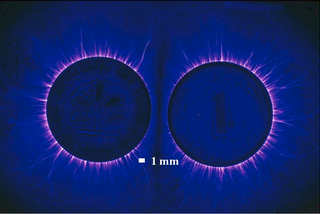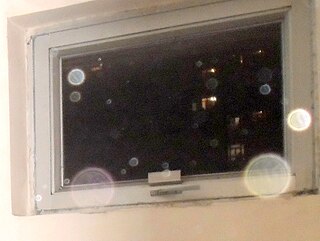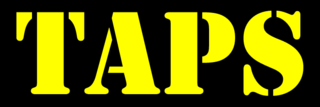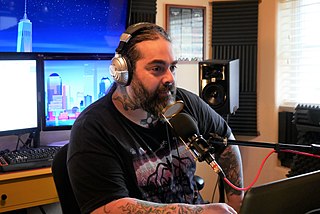
In cryptozoology and ufology, "rods" are elongated visual artifacts appearing in photographic images and video recordings.

Kirlian photography is a collection of photographic techniques used to capture the phenomenon of electrical coronal discharges. It is named after Semyon Kirlian, who, in 1939, accidentally discovered that if an object on a photographic plate is connected to a high-voltage source, an image is produced on the photographic plate. The technique has been variously known as "electrography", "electrophotography", "corona discharge photography" (CDP), "bioelectrography", "gas discharge visualization (GDV)", "electrophotonic imaging (EPI)", and, in Russian literature, "Kirlianography".

A camera is an optical instrument that captures images. Most cameras can capture 2D images, while some more advanced models can capture 3D images. At a basic level, most cameras consist of a sealed box, with a small hole that allows light to pass through and capture an image on a light-sensitive surface. Cameras have various mechanisms to control how light falls onto the light-sensitive surface, including lenses that focus the light and a shutter that determines the amount of time the photosensitive surface is exposed to the light.

In Canadian folklore, the Ogopogo is a lake monster said to inhabit Okanagan Lake in British Columbia, Canada. Some scholars have charted the entity's development from First Nations folklore and widespread water monster folklore motifs. The Ogopogo now plays a role in the commercial symbolism and media representation of the region.

A haunted house, spook house or ghost house in ghostlore is a house or other building often perceived as being inhabited by disembodied spirits of the deceased who may have been former residents or were otherwise connected with the property. Parapsychologists often attribute haunting to the spirits of the dead who have suffered from violent or tragic events in the building's past such as murder, accidental death, or suicide.
A debunker is a person or organization that exposes or discredits claims believed to be false, exaggerated, or pretentious. The term is often associated with skeptical investigation of controversial topics such as UFOs, claimed paranormal phenomena, cryptids, conspiracy theories, alternative medicine, religion, or exploratory or fringe areas of scientific or pseudoscientific research.

Ghost Hunters is an American paranormal and reality television series. The original series aired from October 6, 2004 until October 26, 2016 on Syfy. The original program spanned eleven seasons with 230 episodes, not including 10 specials. The series was revived in early 2019 and aired its twelfth and thirteenth seasons from August 21, 2019, to May 27, 2020, on A&E, after which it was cancelled and then revived for its fourteenth season only months later on Discovery+, which started airing on October 31, 2021. Season 15 began October 1, 2022 on Travel Channel.

In photography, backscatter is an optical phenomenon resulting in typically circular artifacts on an image, due to the camera's flash being reflected from unfocused motes of dust, water droplets, or other particles in the air or water. It is especially common with modern compact and ultra-compact digital cameras.

The Atlantic Paranormal Society (TAPS) is an organization that investigates reported paranormal activity. Based in Warwick, Rhode Island, TAPS was founded in 1990 by Jason Hawes. In 2004, the organization itself became the subject of Ghost Hunters, a popular weekly American paranormal reality television series on the Syfy channel. The show ran for eleven seasons on Syfy in the US. The show aired in the UK nine months after the US premier on Living It.

Theodore Judd Serios was a Chicago bellhop known for his production of "thoughtographs" on Polaroid film. He claimed these were produced using psychic powers. Serios's psychic claims were bolstered by the endorsement of a Denver-based psychiatrist, Jule Eisenbud (1908–1999), who published a book named The World of Ted Serios: "Thoughtographic" Studies of an Extraordinary Mind (1967) arguing that Serios's purported psychic abilities were genuine. However, professional photographers and skeptics have argued that Serios and his photographs were fraudulent.

Joe Nickell is an American skeptic and investigator of the paranormal.

Adobe Lightroom is a piece of image organization and image manipulation software developed by Adobe Inc. as part of the Creative Cloud subscription family. It is supported on Windows, macOS, iOS, Android, and tvOS. Its primary uses include importing, saving, viewing, organizing, tagging, editing, and sharing large numbers of digital images. Lightroom's editing functions include white balance, presence, tone, tone curve, HSL, color grading, detail, lens corrections, and calibration manipulation, as well as transformation, spot removal, red eye correction, graduated filters, radial filters, and adjustment brushing. The name of the software is based on darkrooms used for processing light-sensitive photographic materials.

Spirit photography is a type of photography whose primary goal is to capture images of ghosts and other spiritual entities, especially in ghost hunting. It dates back to the late 19th century. The end of the American Civil War and the mid-19th Century Spiritualism movement contributed greatly to the popularity of spirit photography. Photographers such as William Mumler and William Hope ran thriving businesses taking photos of people with their supposed dead relatives. Both were shown to be frauds, but "true believers", such as Sir Arthur Conan Doyle, refused to accept the evidence as proof of a hoax.

Ghost hunting is the process of investigating locations that are reported to be haunted by ghosts. Typically, a ghost-hunting team will attempt to collect evidence supporting the existence of paranormal activity. Ghost hunters use a variety of electronic devices, including EMF meters, digital thermometers, both handheld and static digital video cameras, including thermographic and night vision cameras, night vision goggles, as well as digital audio recorders. Other more traditional techniques are also used, such as conducting interviews and researching the history of allegedly haunted sites. Ghost hunters may also refer to themselves as paranormal investigators.

Benjamin Radford is an American writer, investigator, and skeptic. He has authored, coauthored or contributed to over twenty books and written over a thousand articles and columns on a wide variety of topics including urban legends, unexplained mysteries, the paranormal, critical thinking, mass hysteria, and media literacy. His book, Mysterious New Mexico: Miracles, Magic, and Monsters in the Land of Enchantment, was published in the summer of 2014 and is a scientific investigation of famous legends and folklore in the state of New Mexico. In 2016 Radford published Bad Clowns, a 2017 IPPY bronze award winner, and he is regarded as an expert on the bad clowns phenomenon.

Pascual H. Romero is an American musician, podcaster, television and film producer from Santa Fe, New Mexico. Previously based out of Los Angeles, California, he is the former vocalist of the death metal band Pathology and former bassist of In This Moment. Romero is co-host of the Squaring the Strange podcast, along with paranormal investigator Ben Radford and caricature artist Celestia Ward.
Craig Varjabedian is a fine-art photographer who explores the back roads of the American West, making pictures of the unique and quintessential. He shares stories of the land and the people who live on it, one photograph at a time. Moving from Canada to the United States in 1970, he currently lives in Santa Fe, New Mexico.

Mysterious New Mexico: Miracles, Magic, and Monsters in the Land of Enchantment is a 2014 collection of thirteen investigations conducted by author Ben Radford into cases involving claims of the paranormal occurring in or with significant connections to New Mexico.
The Doris Bither case, also known as the Entity haunting, was a 1974 investigation into alleged paranormal phenomena in Culver City, California, experienced by a woman named Doris Bither. The case inspired Frank De Felitta's 1978 book The Entity which was made into a 1982 film of the same name starring Barbara Hershey.

















